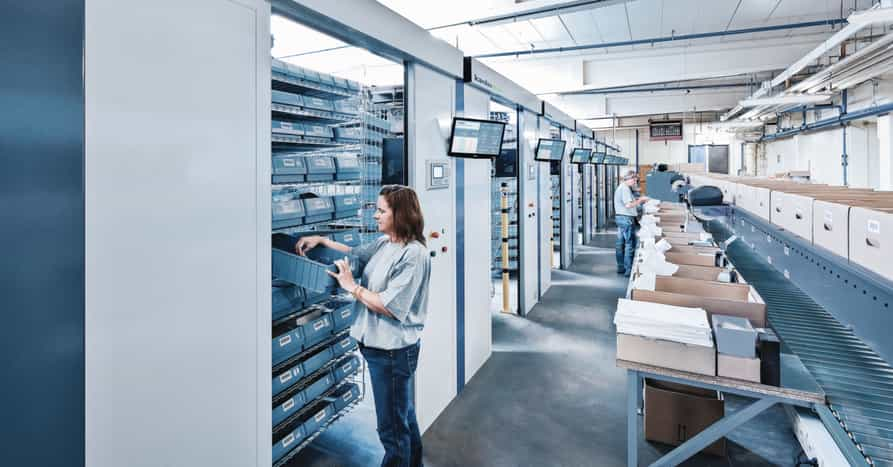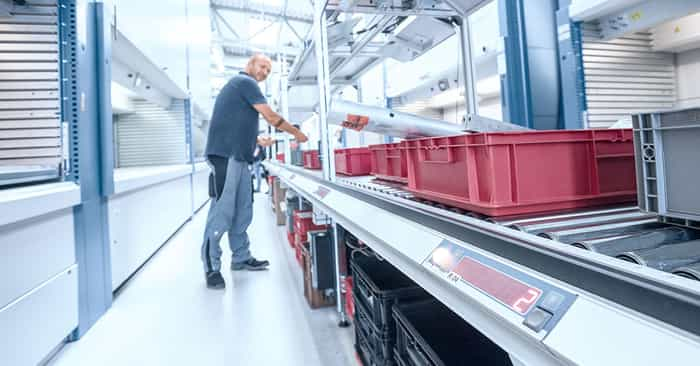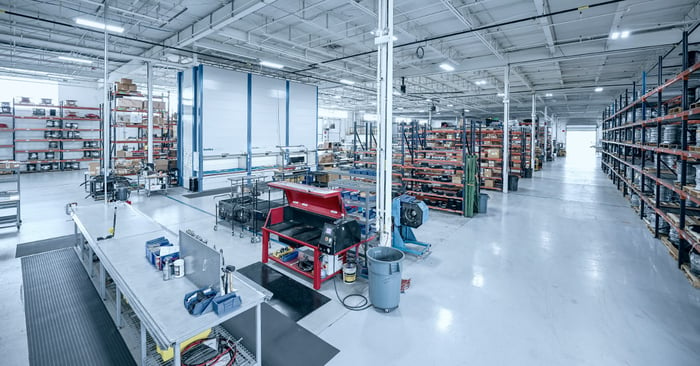In 2020 0 COVID, took the world by storm. With stay at home orders placing many in an initial quarantine, essential businesses - such as manufacturing and distribution facilities - continued to work onsite every day. In addition to masking and constant monitoring for COVID symptoms; social distancing is a core COVID prevention strategy facilities can use to keep workers safe.
As a result, many operations and facilities managers were forced to asses their current processes, reduce employee contact and interaction and adjust to the changing guidelines from the Centers for Disease Controls and Prevention (CDC) to reduce the threat of exposure to COVID.
Social distancing is a simple concept – maintain a 6-foot distance between you and the people around you. But in a manufacturing or distribution facility, we’re talking about 20, 40, 60…up to hundreds of people, who must do their job in a designated work zone and maintain social distance. Adjusting a facility to accommodate these changes can be quite the undertaking. The spread of this virus impacted our communities fast and it’s important to be prepared for this ongoing threat in case we see a second wave in the future.
10 Social Distancing Strategies for your Warehouse
-
Designate 6-foot work areas
-
Separate workstations with partitions
-
Implement one-way traffic flow
-
Utilize signs and visual cues
-
Modify your picking strategy
-
Integrate a tool sanitation station
-
Create "touch free" order consolidation
-
Implement zero-interaction delivery
-
Consider staggering shifts
-
Schedule breaks strategically
Social distancing is just one of the effects COVID-19 will have on manufacturing, distribution, logistics and supply chains globally. If you haven’t already, now is the time to start thinking about how to adapt your warehouse to accommodate this “new normal”. Let's dive into these ten strategies to facilitate social distancing in your warehouse, while saving space and increasing productivity with less labor.
Create & Facilitate Proper Distance Between Workspaces
1. Designate Work Areas At Least 6-feet Apart to Accommodate Social Distancing
To make it clear for your employees, use social distancing visual cues on the floor or at their workstation to designate their assigned space. This helps reduce the chance of coworkers interacting too closely and the potential threat of exposure. 6-feet between workstations is the current CDC social distancing recommendation.
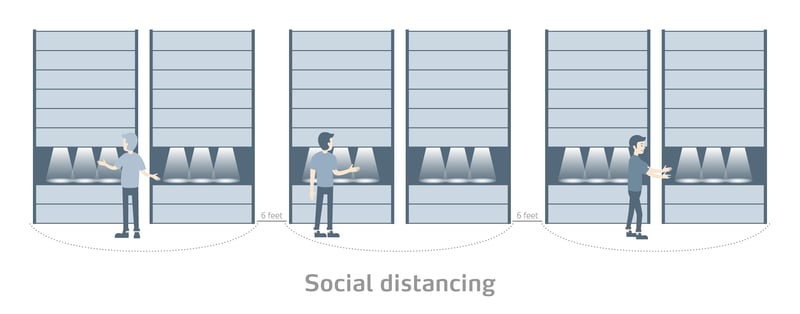
2. Separate Workstations with Social Distancing Partitions
Using social distancing partitions, such as plexi glass dividers, between workstations is an extra precaution and recommended when possible. If you have several employees working on the production line, using a partition to separate their workspaces allows them to work in tandem on the same line, without slowing down the operation.
Expert Tip: Use automation to separate the workstations completely, save space and increase productivity. Integrating automated storage and retrieval systems (ASRS), such as Horizontal Carousel Modules, Vertical Carousel Modules, Vertical Lift Modules (VLMs) and Vertical Buffer Modules (VBMs), into your manual operation can help create socially distant workstations unit by unit. Consolidating inventory into ASRS can increase capacity and save up to 85% floor space. Individual employees can be assigned to one unit or a pod of units. All of the inventory they need can be stored in their assigned unit(s), allowing them to stay within their designated workspace without interfering with others around them. 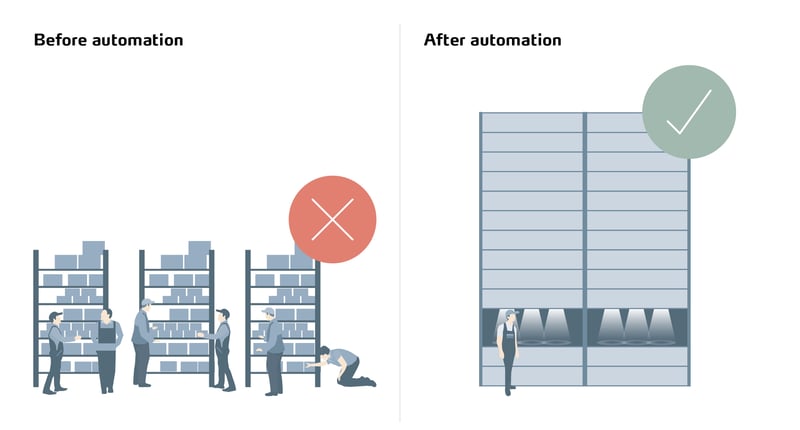
Some systems can be integrated with dual access to allow for multiple users on the front and back of the unit or on different floors. It’s as if the Vertical Carousel Module or Vertical Lift Module is the partition itself, allowing for accessibility at a safe distance.
Remap Your Facility Flow and Asses Your Picking Strategy
3. Ensure One-Way Traffic Flow to Maintain Social Distancing
Using a diagram or map of your warehouse, evaluate the current traffic patterns. Is there opportunity for people to come into close contact just by navigating from the break room to their workstation? To remain compliant with social distancing guidelines, consider adjusting your traffic flow from a two-way street to one-way only. This reduces the risk of employees crossing paths.
4. Use Social Distancing Visual Cues to Identify Traffic Flow
If you don’t already have “roads” in your warehouse, this would be a great opportunity to add them. Now that you have one-way streets, social distancing visual cues to identify this new traffic pattern will make it easy for your employees to navigate the warehouse safely.
5. Consider Modifying Your Picking Strategy
Now that you’ve adjusted the flow of your operations, it’s probably a good time to also look at your picking strategy. Are you using pick and pass, parallel or wave picking? The goal here is to reduce the amount of touches by different people as well as keeping people in their designated workspace to reduce the risk of widespread exposure throughout your warehouse. Not to mention, less touches also means higher productivity rates!

Expert Tip: Automation is a long-term solution for your operation to remain productive and compliant with social distancing. With inventory in a compact footprint, traffic throughout the facility is reduced. ASRS operates on the “goods to person” principle. Instead of workers travelling to and from storage locations to complete a job or order, inventory is delivered directly to the operator at an ergonomic access point, eliminating travel and search time throughout the warehouse. Once parts/items/tools are picked, totes can travel in the new flow you’ve created right to the production line or to the shipping department for processing. One-way traffic won’t slow down your operation if you map it properly.
If your picking strategy needs adjusting, consider adding a batch picking strategy for a productivity boost. This is the process of grouping orders together into batches for picking simultaneously. All you need is a storage method, such as ASRS, a batch station and inventory management software to facilitate this process.
Learn More About Order Picking Strategies: An In-Depth Guide to Warehouse Picking Methods
Designate a Drop Off/Pick Up Area to Reduce the Risk of Contamination
6. Integrate a Social Distancing Workstation for Tool Sanitation
Establish procedures and communicate who is responsible for cleaning and disinfecting shared tools in between use. With a documented process, you can ensure tools are being properly maintained for use by multiple people. If possible, to reduce the risks even further, designate tools to a specific user for their entire shift and clean them at the end of the day for maximum productivity. Use a tote for “dirty tools”, once they are sanitized, they can be returned to their storage location, in safe working condition for the next user.
7. Create “Touch Free” Order Consolidation
Depending on how you’ve adapted your facility flow or picking strategy, consider integrating a “touch free” order consolidation process to compliment your new changes. With the right design, even large consolidation areas can be managed by only one person to encourage social distancing.
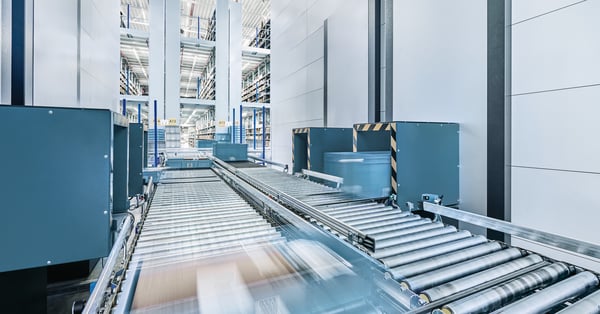
8. Implement Zero Interaction Order Delivery
Create a designated location for the delivery or pickup of completed orders. When delivering a job order to a manufacturing work cell ensure there is a place near that work cell the order can be “left” without the two employees interacting. The work cell employee can then retrieve the order when they are ready.
When delivering completed orders to shipping consider a similar “drop point” that is only accessible to one employee at a time. Better yet, consider using conveyor to move finished orders from the picking area to the shipping area to fully eliminate physical contact with another coworker, reducing the risk of exposure to COVID-19.
Expert Tip: As an enclosed system, ASRS can be the right solution for your drop off/pick up location. ASRS keeps items safe from dust and debris and reduces exposure to contaminants. If one person stores the tool, kit or order, another can retrieve these items without coming into contact with anyone.
If you aren’t currently using automation as part of your consolidation process, consider a Horizontal Carousel Module to increase productivity and provide safe access to multiple users.
Learn More About Order Consolidation: Is Order Consolidation Hurting Your Order Fulfillment Efficiency?
Reduce Labor to Flatten the Curve
9. Consider Operating Multiple Shifts
Reducing labor doesn’t mean layoffs. Instead, consider operating multiple shifts to simply reduce the amount of people in your facility at a given time. Two, even three shifts allows you to remain productive, while reducing the risk of exposure. Even consider picking orders on one shift and replenishing on another because it increases operational efficiencies while employing social distancing. This keeps your employees safe and available to work. If possible, add a break in between shifts for proper cleaning and disinfecting.
10. Schedule Breaks to Reduce Frequency of Where People Congregate
The breakroom is a space you don’t want to neglect as you evaluate your facility. Common breaks are unfortunately a thing of the past. If you schedule breaks, you can maintain social distancing.
Expert Tip: Integrating automation reduces the amount of people you need for picking during each shift. ASRS creates a workstation with proper social distancing and requires 2/3 the amount of labor as traditional shelving operations. If you run multiple shifts, you can even find a productivity boost. When businesses are back up and running at full capacity, you might find yourself with an increase in demand and this increase in productivity will be essential.
In Summary…
In order to protect your employees and your business, you need to start making sustainable social distancing changes in your warehouse today. Take an assessment of your current operations and prioritize the areas with the highest risk first. The end goal is to reduce and eliminate exposure to coronavirus.
Implementing automated storage and retrieval systems into your operation today will help your facility remain compliant for the future. The threat of future outbreaks is high. To ensure your business can remain fully operational given government mandates, CDC regulations and availability of labor, automation is the answer. With automation you can maintain social distancing in your warehouse while saving space, increasing productivity and reducing labor requirements.
Practice proper hygiene. Don’t forget to wash your hands frequently, stay home when possible and wear a mask when necessary. Stay safe out there!

